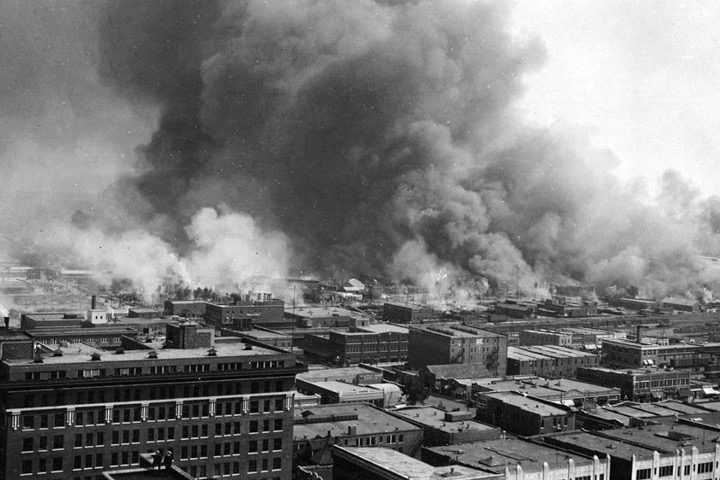
Senator James Lankford (R-Okla.) introduced legislation this past week to establish Tulsa’s historic Greenwood District as a national monument, as the site of the infamous 1921 Tulsa Race Riot (or, as it has recently been called, the Tulsa Race Massacre). In 1921, Greenwood, known as the Black Wall Street due to its relative prosperity, saw about 35 blocks of homes and businesses destroyed in a race riot that evolved into a race war, and finally into a massacre. It is not known exactly how many were killed in the conflagration.
Reuben Gant, the executive director of the John Hope Franklin Center for Reconciliation, was pleased. “Black history is an integral part of American history, and to tell our history in its truthfulness and totality, it includes all of us.” In arguing for passage of his bill, Senator Lankford said, “The Historic Greenwood District/Black Wall Street area in North Tulsa deserves its place among our nation’s significant historic locations.”
The United States has more than 125 national monuments.
Unfortunately, “truthfulness” has not always been the case with commentary on the Tulsa Race Riot, but rather — as so much in today’s political climate — it has been used to advance certain political agendas. Perhaps the most pervasive has been the assertion that the whole sordid episode has been in some sort of Orwellian “memory hole” until just the last few years, presumably as an example of the continued effort of “white supremacy.”
For example, an article in National Geographic History magazine is typical of a myth used to advance a progressive political agenda — that the horrific events in Tulsa in 1921 were “erased” from the history books. This is ironic, coming from some of the same people who want to destroy historical monuments of all sorts across the country and suppress intellectual discussion of historical events by smearing anyone who disagrees with their left-wing interpretations as “racist.”
In the National Geographic History article, Tucker Toole wrote, “Reports of the Tulsa massacre were intentionally omitted from American history until its hundredth anniversary neared.”
This assertion is untenable. The Oklahoma Legislature established a commission in 1997, nearly a quarter century ago, to investigate what actually happened in 1921. I know that when I was a history major in college in Oklahoma in the mid-1970s, the Oklahoma History professor spoke at great length about what was then known about the incident. When I graduated, my first teaching job included an assignment to teach Oklahoma History to ninth graders. The textbook provided by the school for use in the course was the sixth edition of Harlow’s Oklahoma History by Arrell M. Gibson, a professor of history at the University of Oklahoma. I still have a copy of the book, which has a copyright date of 1972.
In the book, Gibson said this about the events: “In Tulsa a black youth was arrested during 1921 on a charge of molesting a white girl. A mob of whites gathered at the jail apparently intent on lynching the accused youth. Violence flared when a countering mob of blacks sought to protect the prisoner. The conflict spread to the black section of Tulsa [Greenwood] where fire gutted two miles of homes and businesses. Seventy blacks and nine whites died in the rioting, and order was restored only by the entry of the National Guard and the application of martial law.”
From that paragraph, one can readily establish that the event was not “omitted.” That was 1972, which is over a half-century ago, and one can assume that since this book was the sixth edition of Gibson’s history book, he most likely covered the event in previous editions as well. In fact, in another Oklahoma history book written by Gibson, Oklahoma: A History of Five Centuries, with a copyright date of 1965, he gives more detailed coverage of the event. This book appears intended for an older audience, perhaps college students, but the wording is similar.
In another book I have in my library (I now teach Oklahoma History, among other subjects, at Randall University in Moore, Oklahoma), Oklahoma: A History of the Sooner State, by Edwin C. McReynolds, this one with a 1954 copyright date, the Tulsa Race Massacre is covered as well. In this book, McReynolds noted, “The crowd of whites broke into hardware and sporting-goods stores, helped themselves to guns and ammunition, and became an uncontrollable mob.” After providing more details of the event, he concluded his discussion with the words, “citizens of Tulsa were heartily ashamed of the entire affair.”
It should go without saying that Oklahoma history books written in the last several years have also devoted space to the whole sordid event.
Exactly how many individuals were killed, and how much property damage was done, is not completely certain. What is known, however, as Professor McReynolds so aptly put it in 1954, is that most citizens of Tulsa were “heartily ashamed” that such a horrific event could take place in their city. And, for them to be “ashamed,” they must have somehow known about it. It had not, and has not, been “erased” from history.
It was also covered in Oklahoma: A Guide to the Sooner State, a book with a 1941 copyright date — which is only 20 years after the event. Compiled by the Writers’ Program of the Works Progress Administration (WPA) and published by the University of Oklahoma, the book states that the destruction of Tulsa’s Greenwood District was “a night of terror,” and calls the invasion of Greenwood the work of “vigilantes.”
It is also shameful that there have been recent efforts to use this tragic episode for partisan political purposes, and to advance a left-wing political agenda, with falsehoods such as asserting that the event had been “intentionally omitted from American history.” Hopefully, this new national monument will not be used that way, as well.

